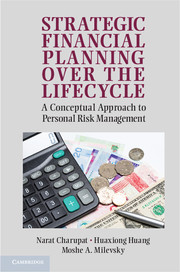Book contents
- Frontmatter
- Contents
- Acknowledgments
- 1 Introduction and Motivation
- 2 Mathematical Preliminaries – Working with Interest Rates
- 3 Personal Balance Sheet and Human Capital
- 4 Consumption Smoothing and Optimal Savings
- 5 Debts, Loans, and Mortgages [Canadian Content]
- 6 Personal Income Taxes [Canadian Content]
- 7 Risk, Utility, and Insurance
- 8 Mortality Risk and Life Insurance
- 9 Investment and Diversification
- 10 The Mathematics of Portfolio Diversification
- 11 Housing Decisions
- 12 Pensions and Retirement [Canadian Content]
- 13 Advanced Material: Part I. Continuous Time and the Calculus of Variations
- 14 Advanced Material: Part II. Stochastic Optimal Control and the HJB Equation
- 15 Concluding Thoughts and Next Steps
- Bibliography
- Index
4 - Consumption Smoothing and Optimal Savings
Published online by Cambridge University Press: 05 June 2012
- Frontmatter
- Contents
- Acknowledgments
- 1 Introduction and Motivation
- 2 Mathematical Preliminaries – Working with Interest Rates
- 3 Personal Balance Sheet and Human Capital
- 4 Consumption Smoothing and Optimal Savings
- 5 Debts, Loans, and Mortgages [Canadian Content]
- 6 Personal Income Taxes [Canadian Content]
- 7 Risk, Utility, and Insurance
- 8 Mortality Risk and Life Insurance
- 9 Investment and Diversification
- 10 The Mathematics of Portfolio Diversification
- 11 Housing Decisions
- 12 Pensions and Retirement [Canadian Content]
- 13 Advanced Material: Part I. Continuous Time and the Calculus of Variations
- 14 Advanced Material: Part II. Stochastic Optimal Control and the HJB Equation
- 15 Concluding Thoughts and Next Steps
- Bibliography
- Index
Summary
Learning Objectives
In this chapter, we look at consumption/investment decisions. During your working years, you have to decide how much of your salary you want to spend immediately and how much to save for the future. We use an economic concept called consumption smoothing, which suggests that people want to optimize their standard of living over their lifetime. They do so by balancing the spending and savings during different stages of their lives. We will see that under this concept, people's standard of living will not wildly fluctuate. Rather, it either remains the same or changes in a smooth fashion over their lifetime.
You will learn to derive your optimal consumption and savings at various ages. You will also see how your financial and economic net worth change over time.
Consumption Smoothing
Imagine the following situation. You are twenty-five years old, and your long-lost and rather eccentric uncle, whom you rarely met and barely know, has just passed away. When the lawyers vet his will, they discover that he left you $25 million as an inheritance. Unbeknownst to your family, he was quite wealthy and he took a liking to you personally. Unfortunately (and there always is abut), themoney has been placed in an iron-clad trust that you cannot access for the next twenty-five years. Even the best lawyers in town cannot break or dissolve the trust documents. Your uncle was concerned about your financial maturity, and he decided it would be best to wait until you are (much) older before giving you the title to this unprecedented sum of cash.
- Type
- Chapter
- Information
- Strategic Financial Planning over the LifecycleA Conceptual Approach to Personal Risk Management, pp. 46 - 78Publisher: Cambridge University PressPrint publication year: 2012

